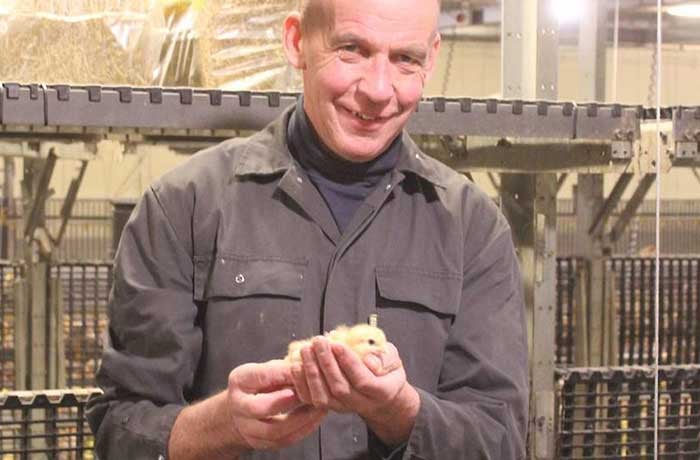In the Belgian village of Kasterlee (near Turnhout) Frans Smets (58) and his wife Rita (57) run a rearing farm for free-range laying hens. Rita has a part-time job and helps out when it is busy on the farm. Their two stables from 2004 provide space for the rearing of 39,500 free-range laying hens; in the newer stables from 2010 59,500 free-range laying hens can be reared. For all three houses, Frans chose the Jump Start system of Vencomatic Group. Frans Smets was the first poultry farmer in Flanders to install the Vencomatic Group Jump Start system on his farm. With Jump Start, Frans is able to supply perfectly trained birds to the poultry farmers who buy hens from him.
Before Frans Smets became a poultry farmer, he worked as a carpenter for fourteen years. At the beginning of the 90s, he took over a broiler farm in Kasterlee with two sheds. Frans: "I started with broilers in 1993. Partly due to the dioxin crisis, around 2003 I wondered how I wanted to continue our business. Because I saw that there was a great demand for free-range hens, I started rearing them in 2004. The advantage of rearing is that you regularly have a rest period for yourself. What also played a part was that I didn't feel good in collecting eggs". He rebuilt his two barns for the rearing of 39,500 free-range laying hens. He opted for the then new Jump Start system.
Trappists
Frans remembers well that in 2004 the vendor of Vencomatic Group sat at his kitchen table for the price negotiation. The sales representative had a nice sales story about Jump Start when he suddenly interrupted his story. Frans: "The salesman looked at me and said: 'Well, as a Fleming, you don't buy anything from a Dutchman, I think'. Then I poured a Trappist. And a few more Trappists we signed and the sale was complete".
Frans was the first poultry farmer in Flanders to install the Jump Start system on his farm. He was declared a fool by fellow poultry farmers, but also by the people at the hatchery. "They said to me: 'Back to loose, that's back to square one'. But I believed in Jump Start and the compensation for rearing was good". In 2010 Frans built a new barn for 59,500 free-range laying hens at a second location a little further away and once again opted for the Jump Start system. He is particularly pleased with the high uniformity of the system: 93% for brown hens and 96% for white hens.
Trained hens
But least as important for Frans is that Jump Start lives up to the promise of 'perfectly trained hens' that will do well in an aviary system. "From day 10, the winchable plateau is pulled up with water by 4 centimetres at a time. So to get to the water, the hens learn to jump higher and higher". In the end, the drinking level is 1.5 metres and the hens can jump well. Frans notices this when he turns off the light at 17 weeks in the evening and the hens are all as high up as possible in their housing. Frans: "When the hens jump up into the system in the evening, they immediately find water and feed in the morning and that ensures that high uniformity. That is also the big advantage of Jump Start over a row system with water and feed at the same level. The advantage of a row system is that you have less work with it. So I opt for a bit more work, but with much more uniformity.
At the end of the day, of course, the poultry farmer who takes the hens from Frans also wants perfectly trained animals. Frans wants the farmer to be content because he pays a lot for the laying hens; he has to be able to earn his money with it and that means, among other things, as few floor eggs as possible. Frans: "Picking up a thousand floor eggs a day is really a nightmare. That's why the hens must have learned to sit upstairs in the evening, because then they lay their eggs in the nest in the morning. That's the idea behind the Jump Start system".
Pop music
For three years now, the Flemish poultry farmer has been content with the system and has been causing problems for hens with whole beaks. Frans: "The KAT no longer wants hens that are missing and the farmers have agreed to this. Out of boredom but also when, for example, intestinal health is not 100%, pecking can occur. Especially because the animals in the Jump Start system run free, you have to keep a close eye on that. So alfalfa and pecking stones; one stone per 1,000 chicks. It is also a matter of adjusting for feed and light. And setting up music: pop music from Studio Brussel. Frans tells us that he sets the music quite loud and this creates a kind of 'camouflage sound' so that the hens can't be frightened by a falling bucket or the sound of an aeroplane.
If Frans Smets were to expand his business now, he would certainly opt for Jump Start again. Frans: "It's because of the people who work at Vencomatic Group. It's all about the chickens there. They are doing their job; you can just feel that. Their goal is a system that is as super as possible. That means a system in which both the farmer and the chickens feel good. Actually, Jump Start is the Bobbejaan land of the hens: they move and they jump and they can go up and down anywhere".












.png?width=160&height=132&name=Egg%20packers%20-%20Vencomatic%20Group%20(2).png)
.png?width=160&height=132&name=Meggsius%20Select%20-%20Vencomatic%20Group%20(2).png)











